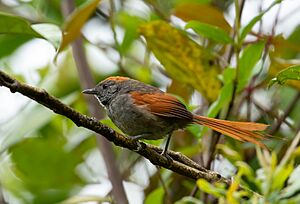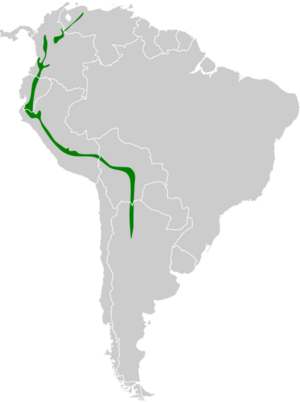Azara's spinetail facts for kids
Quick facts for kids Azara's spinetail |
|
|---|---|
 |
|
| S. azarae, Pasco, Peru | |
| Conservation status | |
| Scientific classification | |
| Genus: |
Synallaxis
|
| Species: |
azarae
|
 |
|
| Synonyms | |
|
|
The Azara's spinetail (Synallaxis azarae) is a small bird. It is part of the ovenbird family, called Furnariidae. You can find this bird in several South American countries. These include Argentina, Bolivia, Colombia, Ecuador, Peru, and Venezuela.
Contents
About the Azara's Spinetail
What's in a Name?
This bird is named after Félix de Azara. He was a Spanish naturalist. A naturalist is someone who studies nature. He explored and described many animals in South America.
Different Types of Azara's Spinetail
There are nine different types, or subspecies, of Azara's spinetail. They are all slightly different in their looks or where they live. Here are their scientific names:
- S. a. elegantior
- S. a. media
- S. a. ochracea
- S. a. fruticicola
- S. a. infumata
- S. a. urubambae
- S. a. azarae
- S. a. samaipatae
- S. a. superciliosa
What Does Azara's Spinetail Look Like?
Azara's spinetail is about 15 to 18 centimeters (6 to 7 inches) long. It weighs about 12 to 18 grams (less than an ounce). Both male and female birds look the same.
The main type, called S. a. azarae, has brownish-gray feathers on its face. It has a slightly lighter stripe above its eye, called a supercilium. The top of its head is dark grayish-brown. The back of its head and neck are a dark reddish-brown. Its back and rump are a rich olive-brown color.
Its wings are mostly reddish-chestnut. The tips of its flight feathers are dark brown. Its tail is a dull chestnut-brown. The tail feathers are somewhat pointed.
The bird's throat is pale grayish with darker tips. The center of its throat is very dark, almost black. Its chest is dark brownish-gray. The belly is lighter and grayer. Its sides and under the tail are browner.
The bird's eyes are reddish-brown. Its upper beak (maxilla) is black or dark gray. The lower beak (mandible) is gray or blue-gray. Its legs and feet are olive-gray or grayish-green.
Young Azara's spinetails look a bit different. They have a brown head and back. Their throat patch is not very clear. Their underparts have a pale brown or yellowish-brown color.
Other types of Azara's spinetail have small differences. Some are paler overall. Some have a white spot near their eye. Others might have a more prominent stripe above the eye. Their colors can vary slightly in different body parts.
Where Does Azara's Spinetail Live?
Azara's spinetail lives in the Andes Mountains. These mountains stretch across South America. Each type of spinetail lives in a specific area:
- S. a. elegantior: Lives in the Eastern Andes of Colombia and western Venezuela.
- S. a. media: Found in the Central and Western Andes of Colombia. It also lives south into Ecuador's Andes.
- S. a. ochracea: Lives in the Andes of southwestern Ecuador and northwestern Peru.
- S. a. fruticicola: Found in northern Peru, in the valley of the Marañón River.
- S. a. infumata: Lives in the Andes of northern and central Peru.
- S. a. urubambae: Found in the Department of Cuzco in southern Peru.
- S. a. azarae: Lives in the Andes from southeastern Peru into central Bolivia.
- S. a. samaipatae: Found in the Andes of southern Bolivia.
- S. a. superciliosa: Lives in the Andes of northwestern Argentina.
This bird likes many kinds of semi-open places. These include the edges of mountain forests and new forests. You can also find them in bushy fields and along roadsides. They often stay in thick plants close to the ground.
In most areas, they live at elevations between 1,500 and 3,500 meters (about 4,900 to 11,500 feet). In Bolivia and Argentina, they can live lower, between 600 and 1,600 meters (about 2,000 to 5,200 feet).
How Does Azara's Spinetail Behave?
Staying in One Place
Azara's spinetail does not migrate. It stays in the same area all year long.
What Do They Eat?
This bird mainly eats small bugs and other arthropods. It also eats tiny seeds. Azara's spinetails usually look for food in pairs. Sometimes, they join groups of different bird species feeding together. They pick food off leaves, small branches, and sometimes dead leaves. They usually stay low to the ground, below 2 meters (about 6.5 feet). But they have been seen feeding as high as 6 meters (about 20 feet).
Building Nests and Raising Young
Azara's spinetail can breed during both wet and dry months. In some places, they might even breed all year. They build a long nest made of sticks. It has a tunnel-like entrance that goes sideways or upwards. The inside of the nest is soft. Sometimes, it even has shed snake skin! They place their nests low in thick plants. A female usually lays two to four eggs.
What Do They Sound Like?
Azara's spinetail is quite noisy. It often repeats a sharp call that sounds like "ket-kwééék" or "pip-squeak." It also makes scratchy, nasal "prrt" notes. Other sounds include "kweek-kweek" notes and a low, short "chur" or "trrt."
Is Azara's Spinetail in Danger?
The IUCN (International Union for Conservation of Nature) says Azara's spinetail is of "Least Concern." This means it is not currently in danger of disappearing. It lives in a very large area. Even though we don't know the exact number of birds, their population seems stable. No major threats have been found. This bird is common in most places where it lives. It can also live in areas where humans have changed the forest a bit.


